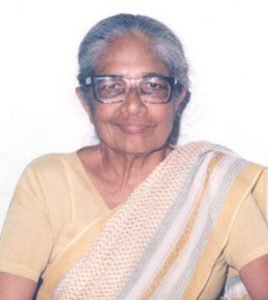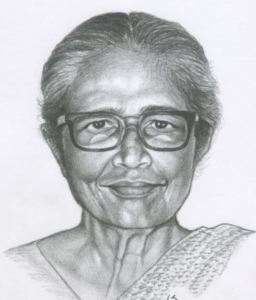Anna Mani was an Indian scientist who had a lot of knowledge about physics and weather. People in India think of her as a gem because she made the ozonesonde, which measures the amount of ozone in the air.
She worked as a visiting professor at the Raman Research Institute and retired as the Deputy Director General of the Indian Meteorological Department. Her books on solar thermal systems are very well known, and she built a weather observatory at the Thumba rocket launch facility.
Google Doodle paid the tribute on Anna’s birthday as a way to honor her. Find out more about the scientist, her family, and what she did before she died.

As a physicist, Anna Mani has a net worth of
Anna Mani’s exact net worth is not known, but she is said to have made at least $100,000 as a physicist, according to several sources.
Anna Mani was born in Peermade, in the Indian state of Kerala. She was one of India’s first female scientists. She was known as “The Weather Woman of India.”
In 1948, Mani was employed by the India Meteorological Department. In the network of solar radiation monitoring stations, she stood for a variety of energy sources. Anna also worked as a Deputy Director General for the World Meteorological Group of the United Nations and the India Meteorological Department.
Mani was once chosen to be a Trustee of the Raman Study Institute in Bangalore. In 1987, she was given the INSA Good Enough. R. Ramanathan Medal for her many well-received works.
A Look at Her Career Through Google Doodle:
People are used to seeing colorful, funny, and timely doodles on Google’s homepage. These doodles celebrate festivals, holidays, and events and pay tribute to famous people and beautiful buildings.
On August 23, 2022, when she would have turned 104, Google used a Doodle to honor an Indian physicist and meteorologist. Google made a thoughtful picture of the weather woman to honor her.
Anna Mani was the seventh of eight children and was born on August 23, 1918. Her father was a civil engineer, and her mother was a stay-at-home mom. No one has talked about how much money her family has, but her parents always encouraged her to do well in school.
Mani died of heart failure on August 16, 2001, when she was 82 years old. She died in Thiruvananthapuram, Kerala. She had a stroke in 1994 that left her unable to move, and after nine years, she died.
More about Anna Mani’s husband and children
Several sources say that Anna Mani never got married. She has spent her whole life doing science and research, and she has never been in a relationship. People say that by the time she was 12, she had read every book in the public library and was very eager to keep learning.
People in the area say that when Mani turned eight, she chose an Encyclopedia Britannica over a pair of diamond stud earrings. In 1925, when Mahatma Gandhi came to her home town, it had a big effect on her. After Gandhi came to India, Anna only wore khadi, which is home-spun cotton, to show that she was a nationalist.
Anna Mani’s first research supervisor at the Indian Institute of Science in Bengaluru was Sir C.V. Raman, who won the Nobel Prize.
She wrote five papers and a Ph.D. dissertation based on her research on the spectroscopy of diamonds and rubies. Even though she had done a lot of the research needed for a Ph.D., she wasn’t accepted because she didn’t have a master’s degree.
She didn’t give up and went to Imperial College London to study meteorological instruments. She went back to the Indian Meteorology Department (IMD) after leaving it and standardized the drawings for making about 100 instruments that measure weather. She was in charge of the design and making of a number of radiation devices.
She also set up stations all over India to keep track of the sun’s radiation, which helped India use solar energy. Her work measuring the speed of the wind in more than 700 places across the country laid the groundwork for the country’s hopes for wind energy.

Anna Mani bio
Anna Mani was an Indian scientist who studied physics and the weather. She worked for the Indian Meteorological Department as the Deputy Director General. She made important changes to the way meteorological instruments are made. She did research and wrote many papers about measuring solar radiation, ozone, and wind energy.
Anna Mani was born in Travancore, in the town of Peerumedu. Her father was an engineer for the city. She was the seventh of a family of eight children. She was a big reader when she was a child. During the Vaikom Satyagraha, Gandhi did things that made her think. She started wearing only Kh?d? clothes after the nationalist movement made her want to. She wanted to go into medicine, but she chose physics instead because she liked it. In 1939, she got a B.Sc. with honors in physics and chemistry from the Presidency College in Madras.
After she graduated from Presidency College, she worked with Prof. C V Raman to study the properties of light in rubies and diamonds. She wrote five research papers, but because she didn’t have a master’s degree in physics, she didn’t get a PhD. Then she moved to Britain to study physics, but at Imperial College London she ended up studying meteorological instruments. In 1948, she went back to India and joined the Meteorological department in Pune. She wrote a lot of research papers about how weather instruments work. She left her job as the Indian Meteorological department’s deputy director general in 1976.
Mani never got married because she worked hard on her studies and research. She was a member of many scientific groups, such as the Indian National Science Academy, the American Meteorological Society, and the International Solar Energy Society. She loved being outside, hiking, and watching birds. For her work, she was given the INSA K. R. Ramanathan Medal in 1987. She had a stroke in 1994 that left her unable to move for the rest of her life. She died in Thiruvananthapuram on August 16, 2001.
Anna May India candle is still used to predict the weather today, and she is known as the “weather lady of India.” On August 23, 2022, a doodle made by Google in honor of the physicist and meteorologist Mani was shown on the homepage of the search engine. She would have been 104 years old if she had lived. Mani is well known for being one of the first women to work as a scientist in the country. At age 30, she started working for the India Meteorological Department, where she helped develop and make different weather-related tools.
She was so successful that, despite working in a low-paying sector at the time, she worked her way up to head of the department in just five years. During her time as head of the department, more than 100 different weather devices were thought of, made, and then standardized so that they could be made in large numbers.
The early life of Anna Mani
Anna Modayil Mani was born in 1918 in Peerma, which was then in the Indian state of Travancore but is now in the state of Kerala. Her family was Christian and from Syria. Her father was a civil engineer who didn’t believe in anything and ran his own business. She was the seventh of eight kids in a family of readers who read books like there was no tomorrow. After Gandhi’s participation in the Vaikom Satyagraha and his nationalist campaign inspired and moved her, she only wore khaki clothes.
Anna Mani Biography
Anna Mani spent her formative years immersed in books. So, when it was her eighth birthday, her family gave her the traditional gift of a pair of diamond earrings. Instead, she asked for a set of the Encyclopaedia Britannica. Literature introduced her to new ideas and gave her a strong sense of social justice, both of which had a big impact on how her life turned out.
Anni Mani Career
Anna Mani started working for Professor CV Raman right after she graduated from Pachai College. During that time, she studied the way diamonds and rubies reflect light. She wrote five research papers and sent in her dissertation to get a doctoral degree, but she was not given the degree because she did not already have a master’s degree in physics.
When she went back to India in 1948, she joined the meteorology department in Pune, where she worked for a long time and studied different weather devices. Mani was in charge of putting together the plans for bringing in British weather equipment. By 1953, she was in charge of a group of 121 men who made up a division.
She was a member of several scientific groups, including the American Meteorological Society, the Indian National Science Academy, the World Meteorological Organization (WMO), the International Association for Meteorology and Atmospheric Physics, and the International Solar Energy Society. Mani was given the INSA K. R. Ramanathan Medal in 1987. People now call her the “Weather Lady of India” because she has done so much in her life.
Anna Mani Family
Anna Modayil Mani was born in the town of Peermade in the Indian state of Kerala in 1918. She was born into a Syrian Christian family that had been there for a long time. Her father was a civil engineer who didn’t believe in anything and ran his own business. She was the seventh child out of a total of eight in her family.
Anna Mani’s family was a typical one for a professional family from the upper class. The male children in the family were trained from a young age for high-level jobs, while the female children were ready to get married. Anna Mani has always known this. But Anna Mani would have nothing to do with it. Literature introduced her to new ideas and gave her a strong sense of social justice, both of which had a big impact on how her life turned out. Because of this, she was forced by the nationalist movement to only wear khadi clothes.